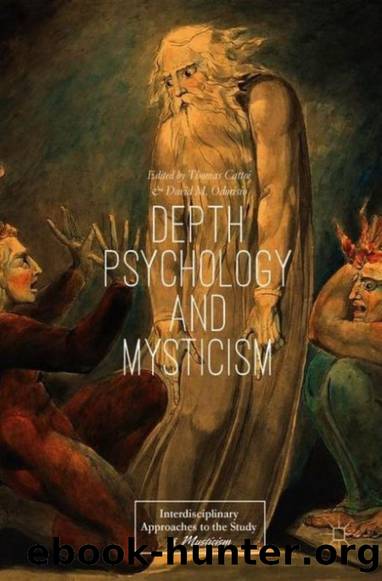Depth Psychology and Mysticism by Thomas Cattoi

Author:Thomas Cattoi [Cattoi, Thomas]
Language: eng
Format: epub
ISBN: 9783319790961
Google: 0QNbDwAAQBAJ
Amazon: B07D4BDDLR
Barnesnoble: B07D4BDDLR
Goodreads: 40796646
Publisher: Springer International Publishing, Cham
Published: 0101-01-01T00:00:00+00:00
In the classic reductive approach, there is no light, only atmospherics and projection, often understood (and easily dismissed) as pathology. In contrast, another strand within the psychology of mysticism has promoted what can be referred to as an adaptive approach. This is illustrated in Carol Zaleskiâs (1987) refusal to side with either the religious or reductive psycho-physiological interpretation of near-death experiences in favor of a Jamesian adaptive, pragmatic perspective on the value of the religious imagination. For Zaleski, it is not so much the different perspectives on the origin of NDE that matters (one emphasizing materialistic reductionism, the other allowing for consciousness beyond materialism) so much as their effect on the life narrative of individuals (usually positive). This is again evident in Kenneth Wapnickâs (1980) analysis of St. Teresa. Utilizing the more âadaptiveâ theories of schizophrenia extant in the 1960s and the case history of a schizophrenic episode (that of Lara Jeffries), Wapnick frames Teresa as an example of a more âsuccessfulâ and adaptive version of what can be called âchurchedâ schizophrenia. Again, engaging Zen, Herbert Fingarette (1965), utilizing case histories run through ego psychology, concludes that the Zen concept of the âno-selfâ is equivalent to âlosingâ the âtransference self.â Buddhism, in effect, is rewritten as a kind of âeastern psychoanalysisâ complete with an âeasternâ nomenclature. While this is undoubtedly a more favorable view of mysticism, one may ask: what has happened to the religious insistence (the âfartherâ side) of the More?
Scholars of religion might begin to answer this question by pointing out that in many cases the psychological reconstruction and understanding of a specific mystical text or figure are not always accurate. That is to say, if one is to analyze a text as an instance of a âcase history,â it behooves one to at least get the case right. Thus, for example, Franz Alexanderâs (1931) pathologizing of Buddhism clearly drew upon suspect third-party sources and bad translations in his âarmchairâ analysis of nirvana (Parsons 2009, 179â210). Again, Wapnickâs (1980) summary of Teresaâs mystical process is more than questionable and obscures the nature and intent of both her âexperiencesâ (not only does he focuses only on the episodic âunionâ of the fifth mansion, which is not as important for Teresa as the permanent âunionâ of the spiritual marriage or the âunionâ of wills, but he also neglects the entirety of visions, raptures, and locutions of Mansion 6) and her âprocessâ (indeed for Teresa the goal is in fact âunionâ with Godâs will, namely an active saintly altruism, mystical âexperiencesâ being but facilitators of that aim). For the scholar of religion, one can only conclude that Wapnick has misread the âcaseâ of Teresa.
The question of âwhat happened to the textâ can take a more convoluted, if not twisted, turn. Take, for example, the contemporary ambivalence concerning the introduction of âmindfulnessâ as part and parcel of a western culture seeking tension release. Adepts in the âtraditionsâ may feel that meditative practices, once uprooted from their metaphysical and ethical matrix, can only lead to a misappropriation of their true aim and import.
Download
This site does not store any files on its server. We only index and link to content provided by other sites. Please contact the content providers to delete copyright contents if any and email us, we'll remove relevant links or contents immediately.
The European History Highway: A Guide to Internet Resources by Dennis A. Trinkle Scott A. Merriman(494)
The Seven Wonders of the Ancient World by Michael Denis Higgins(478)
European Security in a Global Context by Thierry Tardy(470)
European Security without the Soviet Union by Stuart Croft Phil Williams(469)
The Routledge companion to Christian ethics by D. Stephen Long Rebekah L. Miles(458)
Hudud Al-'Alam 'The Regions of the World' - a Persian Geography 372 A.H. (982 AD) by V. V. Minorsky & C. E. Bosworth(399)
Gorbachev And His Generals by William C. Green(391)
Get Real with Storytime by Julie Dietzel-Glair & Marianne Crandall Follis(390)
Tibetan Studies in Comparative Perspective by Chih-yu Shih Yu-Wen Chen(385)
Governance, Growth and Global Leadership by Espen Moe(381)
Hyperculture by Byung-Chul Han(378)
CliffsNotes on Fitzgerald's The Great Gatsby by Kate Maurer(360)
The Oxford History of the World by Fernández-Armesto Felipe;(354)
How Languages Are Learned 5th Edition by Patsy M Lightbown;Nina Spada; & Nina Spada(353)
The Egyptian Economy, 1952-2000 by Khalid Ikram(352)
Oral Poetry and Narratives from Central Arabia: The Poetry of Ad-Dindan : A Bedouin Bard in Southern Najd (Studies in Arabic Literature, Vol 17) (English and Arabic Edition) by P. M. Kupershoek P. Marcel Kurpershoek(345)
The Oxford Handbook of the Incas by Sonia Alconini(333)
Europe Contested by Harold James(319)
The Hutchinson Dictionary of Ancient and Medieval Warfare by Peter Connolly John Gillingham John Lazenby(305)
